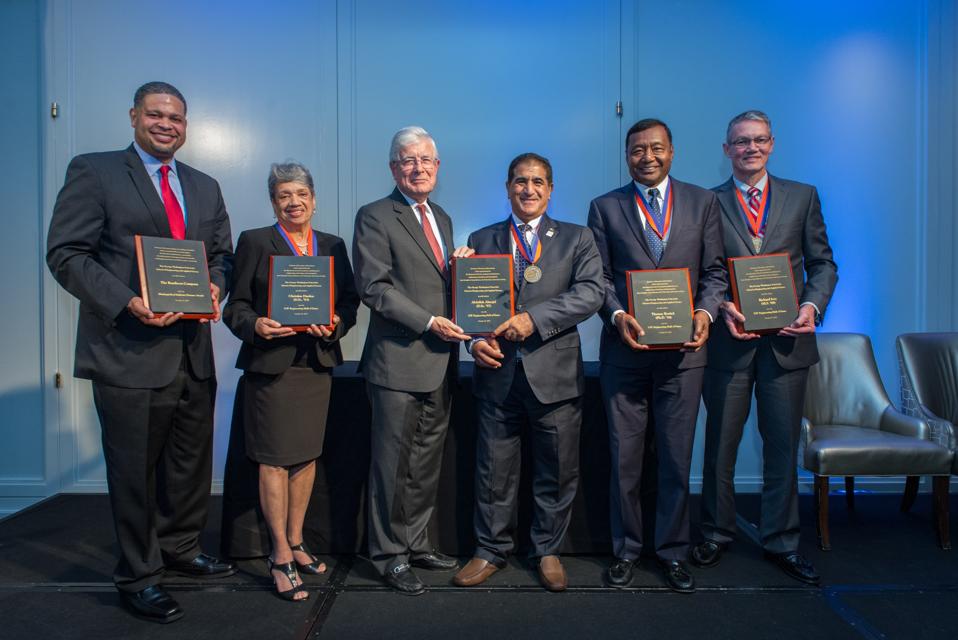In 2017, I was honored to join the ranks of the George Washington University School of Engineering and Applied Science Hall of Fame alongside Dr. Christine Darden, an illustrious figure celebrated for her groundbreaking work in the space race. Darden was one of the four trailblazing African American women featured in Margot Lee Shetterly’s 2016 bestseller Hidden Figures: The American Dream and the Untold Story of the Black Women Who Helped Win the Space Race. Who will follow in Dr. Christine Darden’s footsteps, and how can businesses and government help with the challenge of creating a pipeline of African American women in STEM (science, technology, engineering, and mathematics)? There are significant implications for underrepresentation in the public and private sectors, including the impact on innovation and competitiveness, economic growth, social responsibility and equity, research and development, and public health and safety.
As we recognize Darden’s achievements and those of many women STEM professionals, sobering statistics highlight an urgent need for the public and private sectors to work together to address the underrepresentation of African Americans, particularly women, in STEM professions.
While African Americans make up 13-14% of the total U.S. population, they represent only 6-7% of the total workforce in STEM fields, with African American women constituting a mere 2% of scientists and engineers in the United States. This stark disparity underscores the challenge: How can we cultivate a diverse and inclusive talent pipeline to drive innovation in STEM?
Research indicates that interest in STEM-related studies declines as early as elementary school, particularly in fourth to sixth grades. Public and private sector organizations can help young boys and girls remain interested in STEM. Organizations can help our youth understand the relevance of STEM-related subjects by serving as role models and mentors and providing resources such as lab materials, hands-on experiences, and field trips to see STEM in action. Leaders in the public and private sectors can help address systemic barriers that hinder diversity and inclusion in STEM. Regardless of race or gender, creating supportive and inclusive environments helps all employees feel valued, appreciated, and empowered to thrive as part of a team. However, our efforts must start early. For example, when serving as the Chief of Engineers and Commanding General of the U.S. Army Corps of Engineers (USACE), we partnered with the Department of Defense Education Activity (DoDEA). DoDEA schools provide educational programs for military-connected children worldwide. In 2022, fourth and eighth grade DoDEA students led the nation in scoring on reading and mathematics assessments. Consider: How can your organization take action to help nurture future STEM talent among our elementary school students?
The journey does not end there. Within the talent pipeline, there are many opportunities to lose those who might pursue STEM-related fields. African American college students face a shortage of representation among their peers and professors, which causes a retention challenge in STEM fields. Losing a diverse STEM pipeline has important implications for the public and private sectors.
The challenge of creating a diverse workforce varies significantly by specific STEM discipline or occupation. In biotechnology, where companies are actively developing technologies to combat diseases, comprehensive clinical trials should encompass data from all targeted demographics and populations. However, these clinical trials have often historically underrepresented diverse populations. Biotech companies should strive for leadership that mirrors the diversity of those they serve, actively cultivating trust within underrepresented communities. Implementing mentorship programs can play a pivotal role in this endeavor.
At Ginkgo Bioworks, they have developed a program called Cultivate Fellows, which attempts to help alleviate the high rates of isolation that Black STEM scholars report as a reason for the high attrition rates. The Cultivate Fellowship fosters professional networking, career planning, mentoring, and stipend-based support to help Black STEM scholars interested in synthetic biology. Each public and private organization is responsible for retaining a robust talent pipeline. Engagement must be consistent and extend over a long period. How can your organization take action to help maintain a strong pipeline of STEM talent at the college level?
As an advocate for STEM education, I have personally engaged with fourth-grade students at Randolph Elementary School, emphasizing the practical application of STEM subjects and the importance of perseverance. We can each make a difference one student at a time and over a long period of commitment. One of the students at Randolph Elementary School immigrated to the U.S. from Ethiopia with her parents and later graduated from Princeton with a STEM major. Her success is a credit to her, her parents, and her teachers. However, role models and mentors can inspire students to follow similar STEM career paths.
Businesses that are engaged in developing a diverse and inclusive workforce through recruitment, hiring, and promotion practices develop cohesive, talent-rich teams that enhance their competitiveness and innovation capabilities in an increasingly global economy.
In conclusion, the legacy of Dr. Christine Darden and her Hidden Figures colleagues is a powerful reminder of the impact of diversity in STEM. Their efforts continue to pay dividends for many involved in space exploration today. We must inspire the future “Hidden Figures” in each STEM profession. The public and private sectors must remain committed to investing in the future, beginning with our youngest STEM students. Together, we can foster, develop, advance, and ensure a brighter, more prosperous future for all.

